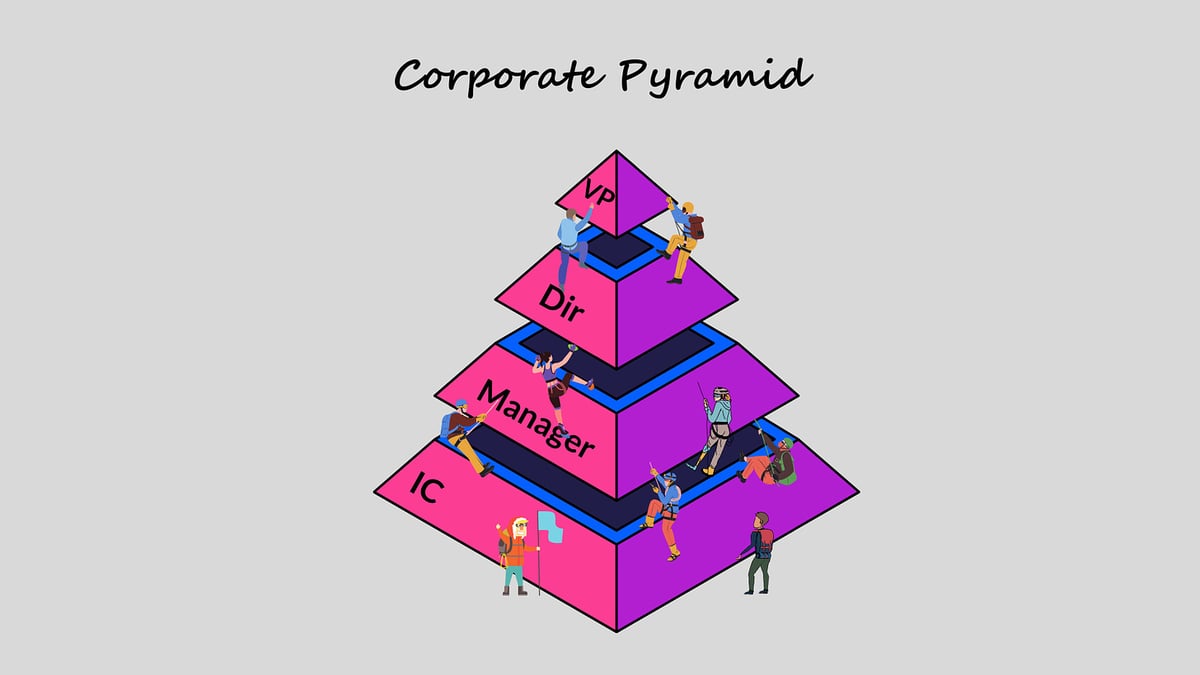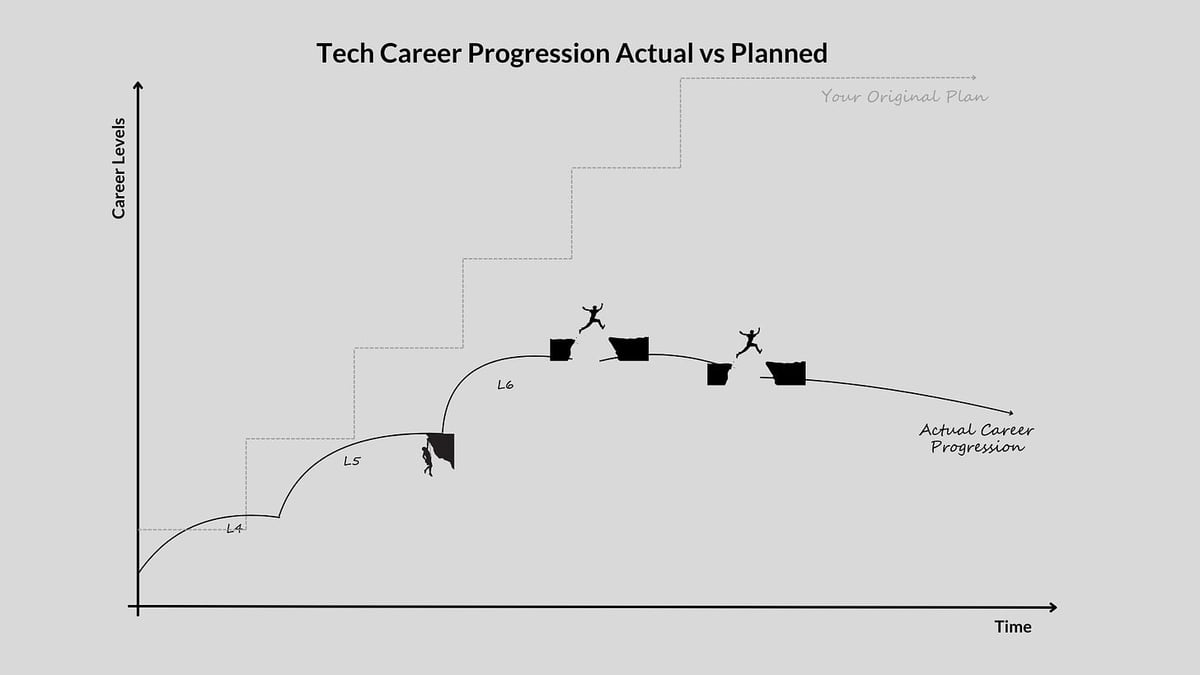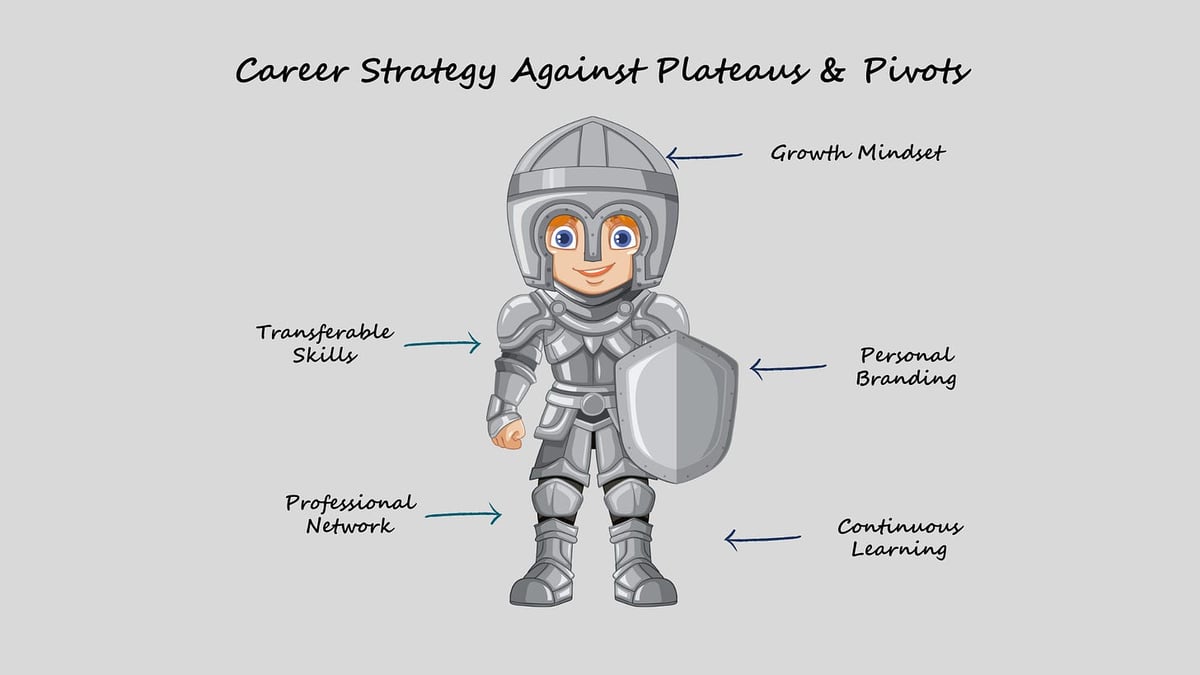So, you want to climb the corporate ladder?
For decades, we've been conditioned to view career progression as an unwavering climb up the corporate ladder. The implicit promise was straightforward.
If you work hard and prove your worth, you will steadily ascend the ladder until you reach the coveted top rung.
Yet this linear path has always been an oversimplified myth. It fails to capture the true complexities and inevitable roadblocks we face over the arc of our careers.

The Pyramid Reality
The reality is that the "ladder" analogy falls apart under scrutiny.
Most corporate hierarchies aren't structured like ladders at all, but rather as pyramids - with roles narrowing significantly towards the apex.
When you start at the base, there are a multitude of entry-level roles and opportunities for growth. You can steadily climb towards higher rungs as you gain experience and deliver results. The path may feel linear and achievable in those early stages.
However, the higher you progress, the more dramatically the pyramid narrows. Roles become scarcer. Competition intensifies fiercely among a shrinking pool of candidates vying for each limited opening. It feels like the Hunger Games, except that it plays out in the corporate environment.
Those who remain rigidly focused on vertical advancement alone will inevitably hit a ceiling; or worse, get edged out entirely as the slope constricts.
Unfortunately, the pyramid's shape makes it mathematically impossible for everyone to ascend to the apex.
No matter your talent or determination, the structure ensures that many will plateau short of the peak. Some will pivot trajectories voluntarily, while others may fall off the path despite their best efforts.

Create Your Own Ladder
Instead of fixating on climbing someone else's predetermined corporate ladder, I propose we reframe our mindsets entirely. It's time to create our own ladders - ones that align with our unique values, strengths, and visions for fulfillment.
By crafting our own pathways, we liberate ourselves from arbitrary constraints and empower ourselves to reinvent our trajectories in lockstep with our personal growth continually.
This isn't just an empowering mindset shift; it's a strategic career imperative.
As industries face disruption (hello, genAI) and the job market remains in flux (more layoffs), rigid adherence to linear progression leaves us vulnerable to obsolescence. Those who can nimbly pivot, acquire new skills, and forge their multidimensional paths will thrive amidst volatility.
The 5 Pillars of Your New Ladder
So how do you create your own ladders?
First, conduct an honest self-assessment to identify your values, talents, and sources of motivation. Then, envision the multifaceted version of personal and professional success that energizes you.
Next, adopt a forward-thinking defensive strategy built on five core pillars. By doing so, you can maintain mobility and continually reinvent yourself on your terms amidst the pyramid's constraints.

🧠 Growth Mindset
Adaptability is central to embodying a growth mindset. It builds on a core belief that your abilities are not fixed, but can be developed through dedication and skilled effort.
Instead of being paralyzed by them, you can view challenges as opportunities to reinvent yourself rather than threats to be avoided. Plateaus are simply new starting lines from which to elevate your skills and expand your horizons.
To cultivate a growth mindset anchored in adaptability, you should
• Reframe obstacles as opportunities for growth.
• Embrace an experimental mindset.
• Continually seek out new challenges that push you beyond your comfort zone.
Who has done it?-
Satya Nadella, CEO of Microsoft, is widely credited with instilling a growth mindset and culture of innovation at Microsoft after taking over in 2014. He shifted the company's focus from being primarily a software company to embracing cloud computing, artificial intelligence, and other emerging technologies, demonstrating adaptability and a willingness to learn and evolve.
💪Transferable skills
Developing a diverse, transferable skill set is crucial for overcoming career plateaus and staying adaptable in today's rapidly evolving job market.
Analyze industry trends and job postings to pinpoint the most sought-after skills in your field or desired career path. These could include technical skills like coding languages, data analysis, or project management methodologies.
Focus on Soft skills like leadership, communication, critical thinking, and emotional intelligence. These skills are highly transferable across industries and roles.
Look for opportunities to work on cross-functional projects or collaborate with teams outside your immediate domain. This exposure can help you develop a broader understanding of different business functions, processes, and perspectives, making you more versatile and valuable.
Who has done it?-
Marissa Mayer is a prime example of someone who leveraged her transferable skills to navigate career pivots successfully. She started her career as a software engineer at Google, where she played a crucial role in developing various products, including Gmail and Google Maps. She then pivoted to become the CEO of Yahoo, applying her technical expertise and leadership skills in a new industry and role.
🗣️Professional network
A strong professional network serves as a valuable source of insights, opportunities, and support that can propel your growth in ways you may not have anticipated. It expands your access to information and resources that can inform your career decisions. You can gain insider knowledge about emerging industry trends, job openings, or even potential business ventures that align with your aspirations.
Perhaps most importantly, a supportive network can offer guidance, mentorship, and encouragement as you navigate the inevitable challenges and uncertainties that come with creating your own ladder.
Here’s my short list of how you can cultivate a robust professional network:
- Actively engage with industry events, conferences, and professional associations related to your field or areas of interest.
- Seek out mentorship opportunities or join communities where you can connect with like-minded individuals.
- Leverage your existing network by reconnecting with former colleagues, classmates, or acquaintances,
- Proactively offer assistance or share your expertise through speaking engagements, writing, or panel discussions.
Who has done it?-
Reid Hoffman, the co-founder of LinkedIn, is a testament to the power of professional networking. He recognized the value of fostering connections early on and built the world's largest professional networking platform. His extensive network has undoubtedly played a significant role in his success and ability to identify new opportunities.
📚Continuous learning
Continuous learning equips you with the agility to pivot and reinvent yourself as industries face disruption and new opportunities emerge.
By consistently expanding your expertise, you can position yourself to explore new roles, projects, or even entirely different fields that align with your evolving interests and goals.
Continuous learning is closely related to the other two pillars. It builds a transferable skillset that increases your versatility and marketability. Moreover, it fosters a growth mindset that empowers you to embrace challenges as opportunities for development.
Here’s my quick take on how you can make continuous learning a habit:
- Explore online courses, certifications, or degree programs that align with your aspirations.
- Attend industry conferences, webinars, or workshops to stay abreast of emerging trends and best practices.
- Consider taking on side projects that push you to acquire new skills and expand your expertise.
Who has done it?-
Kimberly Bryant, founder and CEO of Black Girls CODE, exemplifies the power of continuous learning in career transformation. With a background in electrical engineering and corporate tech roles, Bryant recognized the lack of diversity in the industry. Driven to address this, she immersed herself in learning community organizing, nonprofit management, and curriculum development through workshops, conferences, and mentorship. By continuously upskilling, she launched the successful nonprofit Black Girls CODE, which has empowered over 30,000 young girls from underrepresented communities to pursue STEM fields.
🌟Personal Brand
Personal brand allows you to authentically communicate your unique value proposition, expertise, and aspirations to the world. You can increase your visibility and credibility within your desired sphere of influence.
It can serve as a powerful magnet, attracting like-minded individuals, potential collaborators, or even prospective employers who resonate with your values and goals.
It positions you as a respected authority in your field, opening doors to new possibilities that align with your multidimensional career path.
Perhaps most importantly, personal branding empowers you to take ownership of your narrative and shape how you're perceived professionally.
For a more inside look at why building your personal brand, please read my other article on the topic.
Opening Doors
The beauty of creating your own ladder is that it empowers you to forge a truly multidimensional path aligned with your unique goals and aspirations.
Just because you've hit a perceived ceiling doesn't mean your growth has to stagnate. With a growth mindset and commitment to learning, you can redefine your role and expand your impact within your existing or new team. You will be energized with a newfound perspective and the confidence that you will add more value to your existing role.
If your aspirations or values no longer align with your current role or organization, the pillars empower you to explore new opportunities proactively. Your transferable skills make you a valuable asset across teams and industries, while your professional network can surface potential openings or connections. And your brand precedes you, showcasing your expertise and fit for the new role.
For some, the ultimate expression of creating your ladder is starting your own business or becoming a solopreneur. The pillars provide a powerful foundation for this path and equip you to adapt. Your professional network can be a wellspring of advice, resources, and even initial customers or investors. A strong personal brand is pivotal for marketing your venture, attracting talent, and establishing yourself as a credible authority.
A Self Reflection-
One of the reasons I wrote this piece is that I am experiencing my own career transformation right now. My career plateaued, and I am looking to build my own ladder. I am blessed with the right mindset, given that I have been pretty battle-tested throughout my career.
My first career disruption came during the Internet fallout from which I was laid off. I transformed myself by attending business school and made a career out of management consulting afterward. My second disruption came at the tail-end of my consulting career when I was exhausted from the sales nature of consulting and the amount of traveling. Again, I retooled myself and returned to high tech as a client engagement manager at a few startups. I later entrenched even deeper into tech by returning to my engineering management roots at Adobe and AWS, immersing myself in the forefront of the AI, SaaS, and Cloud revolution.
My love of learning and accumulated transferable skills have sustained my personal growth throughout my transformations.
As I again embark on my journey of self-discovery, I need to focus on expanding my network and outreach, rediscovering my true identity, and building my platform. I am not perfect. But I am convinced that I will come out the other side finding my nirvana.
The Path Forward for Us
The time has come to shed the limiting beliefs that bind us to someone else's predetermined trajectory.
We are the architects of our own destinies, and the world is our canvas. Envision the multifaceted version of success that ignites your passion and energizes your soul.
Remember, creating your own ladder is not a linear process; it's an ongoing journey of self-discovery, adaptation, and reinvention. Embrace the challenges and uncertainties as opportunities for growth, and surround yourself with a supportive network that can provide guidance, encouragement, and accountability.
Take the first bold step towards crafting your personalized ladder. Assess yourself and identify your core values, innate talents, and intrinsic motivations.


